Christine Valters Paintner's Blog, page 136
March 29, 2015
One Space Available in September 22-30, 2015 pilgrimage
 Please join us this autumn for our Monk in the World pilgrimage out of Galway, Ireland. One space has opened up, please contact christine@abbeyofthearts.com if you are interested in joining us.
Please join us this autumn for our Monk in the World pilgrimage out of Galway, Ireland. One space has opened up, please contact christine@abbeyofthearts.com if you are interested in joining us.
March 26, 2015
Monk in the World guest post: Beth Booram
I am delighted to share another beautiful submission for the Monk in the World guest post series from the community. Read on for Beth Booram's reflections about the spiritual practice of hospitality:
Hospitality and Hugs
I was hugging someone goodbye recently when she commented, “Oooh, you’re a good hugger. Thank you!” Her comment seemed genuine and encouraged me because of my awareness that this “good hug” was given with intention. It’s part of what it means for me to offer hospitality. Ever since my husband, David, and I moved into our retreat center and home and began welcoming guests, we’ve been students of how best to receive them into sacred and nourishing space. Our approach has developed over time as we’ve learned and experimented. Almost always, unless a guest conveys otherwise, our hospitality includes a warm and hearty hug.
Friends, family and retreatants who come to us often make the comment, even as they step through the front door, that they feel peace—shalom—upon entering. We hear them speak of how their lives are chaotic and disordered, including the space in which they live. Many parents come for day or overnight retreats just to get away from the constant commotion of children. Pastors and ministry leaders express gratefulness to have a quiet and serene place to tuck into and disconnect from the demands of ministry. And many guests take the time to tell us how soothing it is to be enveloped by an environment that is calm, peaceful, beautiful and well-ordered.
I feel tremendous joy when I hear affirmations like these. A good part of my daily work as a spiritual director, writer and retreat facilitator employs my mind, mouth and ears. In preparing our space to be hospitable, I use my hands to scrub, cook, create and set in place. It’s all for the purpose of preparing a haven of rest and safety for those who come; who need to find respite from their pressure-filled lives and cluttered homes.
When David and I moved from our suburban home into this urban home that houses Sustainable Faith Indy, we began to develop a number of consistent practices to set the table for our guests to feel welcomed. First off, we made sure that our aesthetics were serene and minimal. In our first floor public space where small groups and teams gather, we carefully chose soothing paint colors and well-placed but scant decorations. In our guest rooms, we did the same. A simple Celtic cross hangs on the wall with modest furnishings including a comfortable bed, chair and desk.
Never before have we been as consistent in maintaining a clean home that is in good working order as we are now. We experience this manual labor as part of our sacred work, formation and growth. When I cook and clean, I’m often aware that I’m doing so for someone who will need to be nourished by it. David, as well, would tell you that he’s grown in his own responsibility and thoughtfulness as he changes furnace filters each month and shovels snow off the walk. We are happy—really happy—to put our hands to the task of welcoming our visitors with great care.
When guests arrive they will notice quiet, contemplative music echoing throughout the entry and stairway toward the second and third floors. It’s music that was also chosen very intentionally. Whether Gregorian Chants, classical instrumental music or a beautiful film score, our hope is that each person will feel calmed and quieted by what they hear. Once visitors are welcomed, a cup of hot tea or coffee is offered, as well as a pass by the buffet in the dining room where fresh fruit, nuts and chocolate abound.
Beyond the physical labor to prepare the space there is important work to be done behind the scenes in our own souls. When our guests remark that our place is “full of something” that helps them rest and feel the presence of God, we know that it’s not just the tangible environment. Each morning, David and I enter the day slowly with time to de-clutter our own minds and hearts. How we come to our day and our work, at rest and settled, open and available, is also part of our hospitable intentions. We sense that the prayers we pray linger in us as well as within the walls of our dwelling, offering the Spirit’s presence and peace to those who walk through its front door.
Most recently when guests are arriving or leaving, I’ve felt prompted to give a hug—a good hug—to those who seem comfortable and responsive to one. This physical gesture makes me think of a recent article from the Wall Street Journal that someone showed me. It’s about a growing personal service being offered in cities around our country—cuddling! In this service, you receive up to an hour or even an overnight of cuddles, tickles and snuggling from a professional cuddler—nothing beyond that allowed! (The going rate, by the way, is $80 per hour.) The article confirmed my sense that many people are starved for human touch and connection.
As I live out my calling as a monk in the world, I’m devoted to providing hallowed space and time for individuals and groups to experience healing and repair. I pray that our hospitality and hugs will be for them an entrée into the rest of God and support them in becoming harbingers of Christ’s peace on earth.
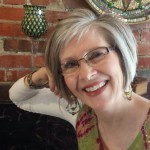 Beth Booram is the co-founder and director of Sustainable Faith Indy, an urban retreat center in Indianapolis, where she leads The School of Spiritual Direction and offers individual and group spiritual direction. Beth has authored several books, including her upcoming book called Starting Something New: Spiritual Direction for Your God-given Dream. (Intervarsity Press, May/2015)
Beth Booram is the co-founder and director of Sustainable Faith Indy, an urban retreat center in Indianapolis, where she leads The School of Spiritual Direction and offers individual and group spiritual direction. Beth has authored several books, including her upcoming book called Starting Something New: Spiritual Direction for Your God-given Dream. (Intervarsity Press, May/2015)
March 25, 2015
Praying with Monks and Mystics book now available for purchase!
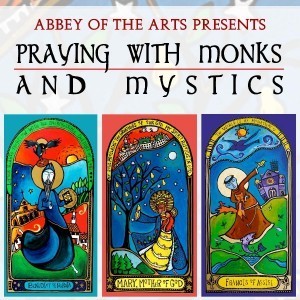 We are delighted to announce that we are publishing a series of materials inspired by our 12 dancing monk icons. The book contains poems, reflections, icons and song sheets to celebrate 12 significant Monks and Mystics through the ages including Benedict of Nursia, Hildegard of Bingen, Brigid of Kildare, Thomas Merton, Francis of Assisi and more! Full color reproductions of the gorgeous dancing monk icons painted by artist Marcy Hall, with poems by Christine Valters Paintner, and the song sheets to accompany the 12 songs we commissioned for each monk and mystic (song recordings will be available on CD shortly, as well as a DVD of dance and gesture prayers).
We are delighted to announce that we are publishing a series of materials inspired by our 12 dancing monk icons. The book contains poems, reflections, icons and song sheets to celebrate 12 significant Monks and Mystics through the ages including Benedict of Nursia, Hildegard of Bingen, Brigid of Kildare, Thomas Merton, Francis of Assisi and more! Full color reproductions of the gorgeous dancing monk icons painted by artist Marcy Hall, with poems by Christine Valters Paintner, and the song sheets to accompany the 12 songs we commissioned for each monk and mystic (song recordings will be available on CD shortly, as well as a DVD of dance and gesture prayers).
March 24, 2015
The Holy Pause: Spiritual Practices for a Time-Obsessed Culture
To receive this love note straight to your in-box, subscribe here (and also receive a free gift!)
For the next few weeks I will be offering you some gems from the Abbey archives as I create the space I need to finish several writing projects and prepare for spring's teaching:
Time is the measure of things that come to an end, but where time itself ends, eternity begins . . . . In the end, there is no end. The ends of time are near the roots of eternity, and the ends of the Earth touch on the other world or the world behind the world.
–Michael Meade
When I lived in Seattle, I was driving to my yoga class one morning, and a race was blocking all of the cross streets I usually travel. I finally found my way around it, but at that point I was close to being late and so started to feel a bit agitated with stoplights and slow drivers in front of me. I could hear the voices start in my mind: "Hurry up, if you don't get there early . . ."
"What?" I interrupted myself. "I won't get my favorite spot in the room? They'll lock the door when class begins and I won't get in?" While those both may be true, the irony of my rushing impatiently to yoga class sank in, and I took a deep breath and let the spaciousness of the moment fill me. Worrying wasn't going to get me to class any faster, and I would be more likely to get into an accident.
I would like to say that this kind of scene plays itself out very rarely in my life, but I would be trying to convince you that I am not susceptible to being very human. The same thing happens when I have too many deadlines and I feel the pressure of too many things to do in too little time. And while I find myself caught in the inner dialogue about time often, I have become more adept at catching myself in these moments.
How many of us wish there were more hours in the day to get things done? As if twenty-six hour days would somehow solve our problems with feeling so rushed and busy all the time. We think that by hurrying we will somehow catch up, but that is the great illusion.
We are all suffering from time poverty in a culture that worships productivity and accomplishments. We become hostage to our calendars. In his book Time Wars, Jeremy Rifkin says, "We have surrounded ourselves with time-saving technological gadgetry, only to be overwhelmed by plans that cannot be carried out, appointments that cannot be honored, schedules that cannot be fulfilled, and deadlines that cannot be met." What is the purpose of managing our days more efficiently if we don't understand the meaning of our days?
Five years ago, I had an experience of confronting my own mortality in a very intimate way. It was profound for me to walk away alive but knowing it could so very easily have been otherwise. I was humbled. And profoundly grateful. As with many others who have had near-death experiences, the days since have indeed cultivated in me an even deeper cherishing of my moments. And yet the irony is that while I am keenly aware of the preciousness of my days and even my hours, overall I don't generally feel more rushed in my life or more compelled to get things done faster. Instead, I inhabit my days more fully so that each one feels more like a wide expanse and an open field of possibility rather than a narrow tunnel nearing its end.
Despite all of our time-saving tools and gadgets, the truth is we need less and less conscious attention to complete the tasks of our day. If anything, we are tempted to multi-task to get as much done as possible at one time so we are never truly present to anything we are doing. Jacob Needleman, in his book Time and the Soul, writes that most of us are like what the Tibetans call "hungry ghosts"—not really existing, not present to life, obsessed with hurrying and doing things right away: "But right away is the opposite of now-the opposite of the lived present moment in which the passing of time no longer tyrannizes us. " He goes on to say that the "hungry ghosts" continue to starve by hungering only after a false illusion of more hours and more days, when what we really hunger for is the present moment. I recognize that I could live a thousand years, but if I am not present to it I will still feel the dissatisfaction and absence of meaning to the end of my days.
When we feel trapped by "no time," we have lost touch with the eternal. The larger culture reinforces this by perpetuating a story that we are nearing the End of Time. Apocalyptic predictions are a part of this larger narrative. We feel victimized by our lengthy "to do" lists and day planners. Clearly, we are living in a period of chaos and decay. When we view time from a linear perspective, we feel as though we are hurtling toward our own untimely ends.
Organic time, on the other hand, is cyclical and sees periods of destruction as making the way for new growth and possibility. Autumn and winter always lead to springtime. When religious traditions write about life after death being eternal, they don't mean that we will live as we do now, only with an endless numbers of days. Instead, we will be immersed in the Now. The purpose of most spiritual practices is to simply arrive right Here, right Now. And for many of us, it will be the longest journey we ever take.
Practices
We begin by stopping for a moment and breathing. It seems so simply and yet is profoundly challenging. How many of us make time to pause? Breathing helps us to enter fully to the moment. We expand physically, which has an effect on our perspective on things.
On a retreat with Brother David Steindl-Rast, he invited us to consider taking a pause as we begin each activity and as we end it. I thought of my yoga practice and how even in the practice of it I can feel rushed, and how things shift when I take three deep breaths at the start and finish of each pose to call myself fully present.
I had some sabbatical time last summer to be away from calendars and email demands. I set up an auto-responder with the subject line, "Holy Pause." I had several people comment how much they appreciated those words as a reminder that they had the choice to take their own holy pause. Give yourself to several small holy pauses during the day and see what you notice. Consider a longer one for a day or more.
Say "no" more often. While being more fully present to my life goes a long way to relieving the anxiety which builds from having too much to do, the more present I am to my life, the more I am able to recognize when adding another commitment would not be healthy for me. Saying no requires that I embrace a healthy sense of humility and knowing that I can't do everything offered to me.
We move so quickly that we forget that there is another deeper layer to reality, one that can only be seen by stopping and arriving here. This is what the mystics write about. We don't need more hours in the day. We need to shift our relationship to those hours. We need to say "no" more often. We need holy pauses. The more we touch the eternal, the more we feel a sense that there is more than enough.
With great and growing love,
Christine
March 22, 2015
Invitation to Dance: Kinship with Creation – How might you nourish an Earth-cherishing consciousness?
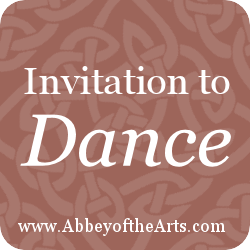 We continue our theme this month of "Kinship with Creation" which arose from our Community Lectio Divina practice with the passage from Psalm 104 and continued with this month's Photo Party and Poetry Party.
We continue our theme this month of "Kinship with Creation" which arose from our Community Lectio Divina practice with the passage from Psalm 104 and continued with this month's Photo Party and Poetry Party.
I invite you into a movement practice. Allow yourself just 5 minutes this day to pause and listen and savor what arises.
Begin with a full minute of slow and deep breathing. Let your breath bring your awareness down into your body. When thoughts come up, just let them go and return to your breath. Hold this image of "Kinship with Creation" as the gentlest of intentions, planting a seed as you prepare to step into the dance.
Play the piece of music below ("Serenade" from the album Pachelbel in the Garden, arranged by Dan Gibson) and let your body move in response, without needing to guide the movements. Listen to how your body wants to move through space in response to your breath. Remember that this is a prayer, an act of deep listening. Pause at any time and rest in stillness again.
After the music has finished, sit for another minute in silence, connecting again to your breath. Just notice your energy and any images rising up.
Is there a word or image that could express what you encountered in this time? (You can share about your experience, or even just a single word in the comments section below or join our Holy Disorder of Dancing Monks Facebook group and post there.)
If you have time, spend another five minutes journaling in a free-writing form, just to give some space for what you are discovering.
To extend this practice, sit longer in the silence before and after and feel free to play the song through a second time. Often repetition brings a new depth.
March 19, 2015
Monk in the World guest post: Stephanie Jenkins
I am delighted to share another beautiful submission for the Monk in the World guest post series from the community. Read on for Stephanie Jenkins' reflections about spiritual direction and the contemplative life:
Disrobe
The wide expanse of sky
echoes your heart’s desire
and you glimpse for
a clear moment
the wings of your own soul soaring.
It is time to stop
tinkering with borrowed dreams
that you wear like an
ill-fitting dress—
stiff-collared, pleated skirt,
your arms limited
by taffeta sleeves.
It is time to shed the layers
and slip into
your own luminous skin.
Tentatively, at first,
you begin to disrobe.
Cantankerous voices mutter
your behavior is offensive,
oblique. As you persist
in your unraveling
of thread and fiber,
buttons and lace
the rumble turns to shouting:
Should!
Must!
Don’t!
Do!
Angry venom bubbles over,
poison eyes, clenched fists.
But you are fully naked now,
not a shred of the old dress left.
The voices are lost in the rush of wind,
and you realize
you are flying.
Sometimes we choose to disrobe and sometimes life strips us bare amidst our loud protests and bitter wailing.
Infertility. That was the diagnosis that caused my own life’s unraveling. My husband and I, young and in love, had plans for a large and happy family, fulfilling the biblical imperative to “be fruitful and multiply.” But after years of trying, of tests and treatments, we had produced nothing but bitter tears and broken dreams. Life was not going according to plan.
I was devastated.
All my life I have more or less gotten what I wanted—or at least what I was taught to want. I faithfully marched along to the persistent beat of social norms and expectations. I have (almost) always been a good girl, an A student, a productive citizen, a church leader, a perfect daughter, a model teacher, a faithful friend, a doting wife.
And for most of my life, this had meant that things worked out pretty well for me overall. I did the right things, and I got the results I was supposed to get. I was a good little girl all year long, and Santa Claus brought me lovely gifts on Christmas Day. This made me feel pretty good about myself. I knew the game, and I could play it well. I was winning!
Infertility. Like a punch in the stomach, it hit me hard. Infertility stripped away my perceived order of things. Infertility forced me to realize that life isn’t like those math tests I used to ace—if I just prepared well, tried hard—no biggie. Infertility taught me life is messy and frightfully painful, that I am not in control, and that God is nothing like Santa Claus.
And for those lessons, I am deeply grateful. In the painful wilderness of grief and depression, I was laid bare. Everything I thought I could count on, everything I thought defined me, was suddenly and completely stripped away. I was entirely naked and vulnerable.
In my fear, as I dangled over the chasm of this grief, I desperately tried to pull myself out or at least hang on. I was terrified of falling.
But somewhere, in the terrible darkness, I heard God say, “Surrender.” I heard God tell me, “Let go.” I heard God speak to me, “Stop trying to make your own light, and just fall.”
And I did. I learned to let go, to free-fall into the darkness. And I learned that falling, as it stripped away the things that hinder, could sometimes feel like flying, and that both flying and falling were drawing me deeper into Love. Love is bigger than the darkness. Love is greater than the pain.
Over the last few years, through tender care and intentional practices, through learning to hold both my own goodness and my brokenness before the One who loves me, I have largely healed from the grief of infertility. The wound is tender still, but it no longer throbs and bleeds as it once did. This is evidence of Love at work.
I am no longer freefalling into grief. But now in this spacious place of health, I look at my life—which doesn’t look at all like what I’d planned—and I sometimes think, “Now what?” It’s tempting for me to fall back into the old pattern and look for Plan B. “What am I supposed to do? I’ll do that.” However, I know now, this is no longer my way.
As a monk in the world, I am called to live authentically into who I am at the core. Infertility stripped off the false pretense of perfectionism and control and made me see that Love is bigger. And I am called to choose Love each day. I am called to strip off the demands, the deadlines, the pressure to perform and conform. I am called to live in to and out of my heart.
My sacred symbols have become the feather and the leaf. Whether I am flying like the feather or falling like the leaf, I am surrendered to God who is greater than I.
I am loved. I am Beloved. That is more than enough. It is in this great Love that I am naked and unashamed.
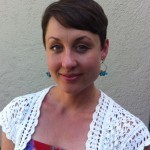 As a Southern California native, I love the warm sunshine, beautiful beaches, and colorful sunsets this slice of the world has to offer. I live with my wonderful husband of twelve years in Los Angeles, where we both teach in the public schools. Though teaching middle school English is a sacred work that I enjoy, I am learning that my true vocation is the spiritual life–discovering the pulsing Beauty that shimmers in all things. On this journey towards ever deepening Love, I have been enriched through my practices of yoga, art, and silent times in nature.
As a Southern California native, I love the warm sunshine, beautiful beaches, and colorful sunsets this slice of the world has to offer. I live with my wonderful husband of twelve years in Los Angeles, where we both teach in the public schools. Though teaching middle school English is a sacred work that I enjoy, I am learning that my true vocation is the spiritual life–discovering the pulsing Beauty that shimmers in all things. On this journey towards ever deepening Love, I have been enriched through my practices of yoga, art, and silent times in nature.
March 16, 2015
Welcome to Liz and Melinda
It takes a lot of work to keep an online monastery running smoothly. We have been in need of admin support for a while now and finally are able to welcome in the help we need. We are delighted to introduce Liz Rasmussen and Melinda Thomas Hansen. Liz will be helping reply to some of the emails which come through and Melinda will be working behind the scenes to get blog posts up and the email newsletter sent out.
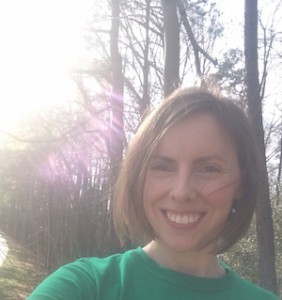 Melinda Thomas Hansen practices living as a monk in the world through meditation, writing, art, yoga, and engaging in relationship. A long time yoga teacher Melinda blends ancient wisdom with modern understanding to guide others from feeling stuck, disconnected or uninspired to a vibrant, creative and nourishing daily experience of Life. She lives in North Carolina with her husband, one year old son and their cat. Visit her at www.thehouseholderspath.com.
Melinda Thomas Hansen practices living as a monk in the world through meditation, writing, art, yoga, and engaging in relationship. A long time yoga teacher Melinda blends ancient wisdom with modern understanding to guide others from feeling stuck, disconnected or uninspired to a vibrant, creative and nourishing daily experience of Life. She lives in North Carolina with her husband, one year old son and their cat. Visit her at www.thehouseholderspath.com.
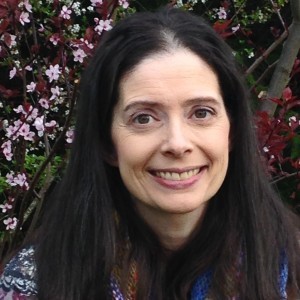 Alizabeth Rasmussen is a freelance writer, photographer and baseball-mom whose work has appeared in damselfly press, Wild Violet and Mused: The Bella Online Literary Review, among others. After the stroke (June 2013), she has been focusing on her healing, which includes a lot of slowing down (or she's trying, it's a practice!). She volunteers at the hospital for the stroke group, and the chaplaincy program. She's training to be a Spiritual Director at the Franciscan Center in Portland, OR. She blogs regularly at Write Click (www.writeclick.me)
Alizabeth Rasmussen is a freelance writer, photographer and baseball-mom whose work has appeared in damselfly press, Wild Violet and Mused: The Bella Online Literary Review, among others. After the stroke (June 2013), she has been focusing on her healing, which includes a lot of slowing down (or she's trying, it's a practice!). She volunteers at the hospital for the stroke group, and the chaplaincy program. She's training to be a Spiritual Director at the Franciscan Center in Portland, OR. She blogs regularly at Write Click (www.writeclick.me)
The Grace of Flowering
To receive this love note straight to your in-box, subscribe here (and also receive a free gift!
This is not a poem
but a rain-soaked day keeping me inside
with you and you loving me like a storm.
This is not a poem but a record of a hundred mornings
when the sun lifted above the stone hills outside my window.
This is time for boiling water poured into the chipped cup
holding elderflower, hawthorn, mugwort.
This is not a poem but me standing perfectly still on the edge of the lake
in autumn, watching a hundred starlings like prayer flags fluttering.
This is my face buried in May’s first pink peony,
petals just now parting, eyes closed, inhaling.
This is not a poem but the field beyond thought and judgment
and the ways I tear myself apart on too many fine days.
This is the place where clocks no longer matter unless
it is the dusty gold watch which belonged to my grandfather.
This is not a poem but me standing desolate in a parade
of white gravestones, when a single bluebird lands and sings.
This is the bunch of Gerbera daisies you handed to me one foggy
February afternoon, pale yellow like the long-forgotten sun.
This is the first bite of bread after too many hungry days,
this is my grandmother whispering her secrets to me after dusk.
This is not a poem, but me taking off my clothes
and stepping eagerly into the cold mid-December sea.
This is the silence between breaths and in that stillness
this is me saying yes and yes and yes.
—Christine Valters Paintner
Dearest monks, artists, and pilgrims,
In the northern hemisphere the earth turns toward the growing light and the call to flower forth into the world, while the southern hemisphere is moving toward the healing darkness and a call to lie fallow for a time. I love seasonal wisdom, and especially knowing that these complementary energies are embracing the earth at the same time. In the monastic tradition, praying the Hours means honoring this move into the gifts of both light and darkness with each day, so we can become more in tune with the rise and fall, fullness and emptiness of earth's cycles.
The poem I share above is one inspired by the poet Rainer Maria Rilke who is part of our dancing monk icon series. I love this image that life itself is the poem and we are called as monks in the world to cherish and savor moments. In spring this might mean making time to be among the profusion of flowers as they begin to appear on your corner of the earth. My favorites are the peonies which will show up soon at our local farmer's market. (Very soon we will have a book with the icons printed in full color accompanied by my poems available, along with a CD with songs for each monk/mystic, and a DVD with dance prayers. . . stay tuned for more flowering!)
I have been feeling spring energies keenly alive in my own soul's being these last couple of months. This past season has been a rigorous one of identifying deep attachments and places of grasping and then slowly letting them go. The inner journey is always demanding but full of grace when we are willing to do the hard work. I am feeling such a sense of springtime within right now.
I love that the Abbey has its own rhythm following the seasons as well. Our winter has been a quiet one of offering online retreats and working on our own writing projects. We are now moving into our live teaching season, with a pilgrimage starting Wednesday in beautiful Glendalough, Ireland. Please send some blessings for our wondrous pilgrims who are preparing and traveling right this very moment.
Here is a bonus reflection for you from the Abbey archives on beginning again now that we are midway through Lent. Has your Lenten commitment fallen away? Take heart and know that the path of the monk is not to berate ourselves, but to humbly begin again.
Part of the spring flowering is our move finally to bring in some more administrative help to support all that happens here at the Abbey. Please welcome Melinda Thomas Hansen and Liz Rasmussen. You can read a bit more about them below. I am so grateful for both of them and you may be hearing from them on occasion when you contact the Abbey.
I have just finished creating the Spring Equinox mini-retreat for our Sacred Seasons 2015 program. This is our yearlong journey through the Celtic Wheel of the Year and began with Imbolc and a free preview of the kind of material available as part of the program. There is even an optional secret Facebook group for conversation and reflection. Join us now to dive into the Spring Equinox and commit to a slow-paced journey in tune with the seasons over the next several months.
With great and growing love,
Christine
Photo by Christine: St. Kevin sculpture in Glendalough
March 15, 2015
Mid-Way through Lent: Beginning Again
For the next few weeks I will be offering you some gems from the Abbey archives as I create the space I need to finish several writing projects and prepare for spring's teaching.
In the middle of the journey of our life
I found myself astray in a dark wood
where the straight road had been lost sight of. —Dante Alighieri, The Divine Comedy
Dearest monks, artists, and pilgrims,
We are approaching the midpoint of our Lenten journey through the desert. This is a ripe moment to pause and reflect on the commitments we made in earnest almost a month ago as ash was smeared across our skin, reminding us of the preciousness of our days.
The human heart is a funny thing, full of passion for spirit one day and then feeling lost or astray the next. Then we may start to berate ourselves for not being better, more committed, more diligent. In that barrage of inner voices that rise up, we often find ourselves so much further away from our heart's desire than when we began. This very act of self-judgment actually distances us even further from our deep longings for peace and rest.
Or perhaps we encounter what the desert monks called acedia, which is translated in different ways but essentially means slothfulness, and has been called the "noonday demon." Halfway through our journey we find ourselves bored. Our spiritual practice wanes, perhaps because we had high expectations about how we would be transformed by now, and so the realities of daily life dull our commitment.
This is why we call it practice. The monks knew that the only response to acedia was to continue to practice. When we feel full of judgment for ourselves, the only response is to continue to practice. We can construct all kinds of ways to abandon the conscious journey and return to a life on the surface of things. These are the temptations of the heart, written about by mystics for centuries, so why should we be surprised that we confront these same struggles as well?
The Lenten journey goes straight through the heart of the desert. In the middle of that parched land where everything comfortable is stripped away, we often find ourselves wanting to run or go to sleep.
Monastic spirituality calls us to return again and again to the practice of showing up, of being still, of opening our hearts to an encounter with the holy. In the Sayings of the Desert Fathers we hear this story: Abba Moses asked Abba Silvanus, "Can a man lay a new foundation every day?" The old man said, "If he works hard he can lay a new foundation at every moment."
St. Benedict in his Rule writes about the commitment to always we begin again, to be a beginner in all things. The desert is a place of new beginnings. No matter how far I stray from my practice, there is always an invitation to begin again. Not just each day, but each moment offers us the chance to lay a new foundation.
In the philosophy of yoga I love the concept of tapas, which means fire or heat and essentially is the discipline we need to show up to our practice again and again. There will be days when we don't feel like coming to the mat or the cushion or our quiet corner. There will be days when life seems to actively conspire against this and we begin to believe that the stillness just isn't possible for us or that our lives are too full to cultivate genuine presence. This is acedia talking, a kind of inner dialogue that sabotages our sincerest efforts. When this happens—and it will happen—our invitation is to gently notice this and begin again. We bring the fire of tapas back to our practice, we commit to showing up over and over.
Practice
Take some time this week to reflect back on your Lenten commitments and promises. Notice over the past several weeks how you get thrown off your rhythm of practice. What are the circumstances of life that seem to conspire against your best-laid plans? What are the thoughts that rise up in response? What are the judgments you hold about yourself in these moments? Just notice these gently without more judgment.
Then connect to your breath, allow it to be slow and full. Savor a few minutes of silence, drawing your awareness down into your heart and resting there in the infinite source of compassion. Bring that compassion to yourself. Hold yourself lightly, perhaps even seeing the humor in your patterns. Humor is rooted in the word humus, which means earthiness and is also the root of the word humility. Acknowledge that you are human and that to be human means to forget sometimes our deeper desires. Embrace your imperfections as the landscape of your journey, the detours that take you into dark woods sometimes so that you feel lost.
From this compassionate, humorous, and humble place, make a commitment to begin again. Make a promise to lay a new foundation in every moment as best as you can. And when you fall away from your commitment again, return yourself to it gently over and over. Let your breath kindle the fire and heat within you necessary to keep showing up. Let this be your Lenten practice and your life practice, this beginning again and again.
With great and growing love,
Christine
Invitation to Poetry: Kinship with Creation – How might you nourish an Earth-cherishing consciousness?
Welcome to Poetry Party #86!
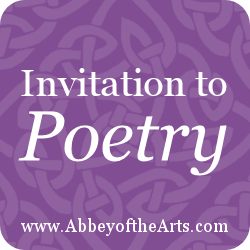 I select an image and suggest a theme/title and invite you to respond with your own poem. Scroll down and add it in the comments section below or join our Holy Disorder of Dancing Monks Facebook group and post there.
I select an image and suggest a theme/title and invite you to respond with your own poem. Scroll down and add it in the comments section below or join our Holy Disorder of Dancing Monks Facebook group and post there.
Feel free to take your poem in any direction and then post the image and invitation on your blog (if you have one), Facebook, or Twitter, and encourage others to come join the party! (If you repost the photo, please make sure to include the credit link and link back to this post inviting others to join us).
We began this month with a Community Lectio Divina practice with a passage from Psalm 104 and followed up with our Photo Party on the theme of Kinship with Creation, part four of the Monk Manifesto. (You are most welcome to still participate). We continue this theme in our Poetry Party this month. What are you continuing to discover about your own relationship with Creation? What does the image above evoke for you? Express this through poetry.
You can post your poem either in the comment section below*or you can join our Holy Disorder of Dancing Monks Facebook group (with more than 2900 members!) and post there.
*Note: If this is your first time posting, or includes a link, your comment will need to be moderated before it appears. This is to prevent spam and should be approved within 24 hours.






